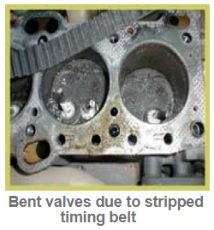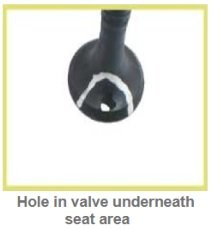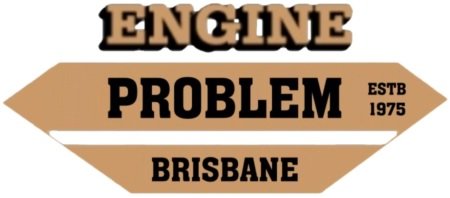Valve Engine Problem

Valve engine problem - CRACKED
Under certain conditions such as excessive high engine operating temperatures valve heads may crack.
Complete pieces of the valve head will suddenly fallout. This will be accompanied by immediate engine noise and miss-firing.
This condition is usually the result of continued use under constantly changing conditions. (constant heavy / light load and temperature changes). With these driving conditions careful inspection of all valves and associated components will be necessary. Any suspect valve should be replaced as the operating conditions are common to every cylinder. Other valves may have cracks from the outer edge towards the centre of the valve head. An example of a vehicle operating under these conditions could be a mail delivery van going from full throttle to idling between each delivery.
The constant change between excessively high temperatures and normal temperatures alters the structure of the valve material and cracks begin to form. With continued use under these constantly changing conditions the valve will eventually crack so a piece will suddenly become dislodged.
Where as consistent overloaded conditions with constant high temperatures can change the valve material differently to become soft or malleable and the valve head will tulip or have a concave appearance.
: Every care has been taken in writing this information and procedures, but no responsibility can be excepted for errors, omissions or misuse of this information and procedures. The information available on this site is for your instruction only and cannot be copied for sale, © copyright 2020 UMR Engines www.engineproblem.com.au

Valve engine problem - PICKED UP / SEIZED
Valve guides and valve stems operate under very harsh conditions. There is a fine line between oil control and the lubrication requirements of the valve stem and valve guide. Due to the extreme temperature exhaust valves operate at it is more common for an exhaust guide seizure than an inlet guide seizure.
With minimal lubrication that exists at valve guides and valve stems it is crucial to run the correct valve /guide clearance.. Things to check when valves seize are: oil feed to valve gear, operating temperature, valve guide clearance , valve stem finish and carbon build up at port side of stem. If valves are bead blasted during a valve grind and the valve stems were not protected or re-polished the roughened finish from bead blasting could contribute to seizure.
Extra friction caused from the course finish will generate more heat which will contribute to seizure due to the minimum lubrication available at the stem area. Dry assembly of valve to guide is also a common cause.
Unlike most other high friction points in an engine valve guides are almost completely sealed from lubrication. Quite often the valve stem will momentary seize in the guide and free itself. This condition usually ends up with a flogged out guide as the stem now has welded material stuck to it that rapidly wears out the guide.
As engines start to burn a little oil, carbon starts to build up on the lower half of the valve stem. If no carbon relief was made at the lower end of the guide this carbon can make the valve start to stick or eventually seize in the guide. The early symptoms of this problem is an inconsistent engine miss at idle accompanied by a loud inconsistent tappet noise. If the engine is driven without this problem rectified a burnt out valve will normally be the result. This condition does not allow good valve to seat contact so as to dissipate the heat from the valve head.
Valves can seize in a guide as a result of a bent valve. This usually happens when a valve clips a piston during an over rev and suffers a minor bend at the head and stem of the valve. Incorrect camshaft timing can also be responsible for the valve damage. The bent valve is forced into the guide by valve spring tension but jams partially open. This can cause further valve and piston damage as the valve stops in a position for further contact with the piston. As the engine continues to rotate the valve eventually breaks out the lower half of the guide. Continued use of the engine will eventually result in a major breakage of the valve and piston.
: Every care has been taken in writing this information and procedures, but no responsibility can be excepted for errors, omissions or misuse of this information and procedures. The information available on this site is for your instruction only and cannot be copied for sale, © copyright 2020 UMR Engines www.engineproblem.com.au

Valve engine problem - BENT / BROKEN
Bent valves are usually the result of a collision between the piston and the valves.
In DOHC engines the collision can occur between the inlet and exhaust valves. The most common cause of the valve making contact with the piston is an interruption to the cam shaft timing. This is usually caused by a timing belt or timing chain failure. The photo is an actual instant where a timing belt failed due to the belt adjuster lock nut not being tensioned correctly at a retail service centre. The investigation and insurance repair was given to us and we obtained these photos as part of our report. The belt ran very loose for a considerable period stressing every tooth on the timing belt. Finally the belt stripped and all the exhaust valves contacted the four pistons and were bent and snapped at the stem.
Some manufacturers by design make their engines what we call "a safe engine", which means even with a broken timing belt the valves don't contact the pistons. Unfortunately this was not one of these. Another cause is valve bounce during over revving. This can cause contact of the valve to the piston and bend the valve. Even without piston to valve contact the stress from continued valve bounce can cause the valve head to fracture at the neck of the valve.
Excessive tappet clearance will cause the valve to contact the seat at a higher speed which can also stress the valve head and stem to breaking point. (the valves contact the seats while further up the lobe profile rather than from the closing ramp.)
The induction of foreign material is a more uncommon cause.
: Every care has been taken in writing this information and procedures, but no responsibility can be excepted for errors, omissions or misuse of this information and procedures. The information available on this site is for your instruction only and cannot be copied for sale, © copyright 2020 UMR Engines www.engineproblem.com.au

Valve engine problem - WORN OUT
Valve stem wear is a normal occurrence after many thousands of miles are clocked up on an engine.
The premature appearance of severe stem wear and guide wear is abnormal. There are many causes of this condition and care must be taken to ensure the cause is eliminated at the time of guide and valve replacement.
- Insufficient guide clearance after a cylinder head overhaul can cause the valve stem to momentarily seize up and subsequently create aggressive wear in the guide or stem.
- Bad guide to seat alignment will accelerate stem and guide wear as extra side thrust is placed on the head of the valve as it attempts to square up onto the seat.
- Incorrect rocker arm geometry will exert abnormal side thrust on the tip of the valve causing abnormal stem and guide wear.
- Lack of stem lubrication is another cause and should be checked upon reassembly. There are many different methods used to ensure oil finds its way to the valve guides. Most times a small oil drilling or spray bar is used to lubricate the rocker assembly and valve guides. Check operation of oil system after assembly.
- Dry assembly and dry start can cause the initial damage that accelerates the stem wear. Use good quality, clean engine oil to saturate the guide and stems upon assembly.
- Not polishing valve stems after unprotected bead blasting of valves will cause accelerated guide and stem wear.
: Every care has been taken in writing this information and procedures, but no responsibility can be excepted for errors, omissions or misuse of this information and procedures. The information available on this site is for your instruction only and cannot be copied for sale, © copyright 2020 UMR Engines www.engineproblem.com.au

Valve engine problem - BURNT
There are many reasons for burnt out valves. Some times it is a combination of reasons but it is generally easy to determine the major cause.
- Weak valve springs: check valve spring tension and free length also check installed height.
- Low seat height: check valve installed height and valve recession.
- Worn valve guides: check guide wear.( using a new valve as a gauge is the simplest method)
- Worn valve stems: measure valve stem in all positions of wear.(micrometer is the best method)
- Incorrectly set tappets: this can only be determined before strip down. (hydraulic tappet depression should also be checked)
- Incorrectly faced valves: check valve face finish. (finish should be fine without any chatter or flats) check valve for run out. Check for correct face angle. Should be 1 degree different, to allow contact at top side of seat.
- Incorrectly cut seat: seat contact position on a valve should be around .1 to 1.5mm away from the valve margin.(the centre third of the valve face )
- Incorrect seat width: The seat contact width is generally between 1 and1.5 mm. Generally three angles are involved in seats. Check the seat angle is either 45 or 30 degrees, with a top cut angle of 30 or 15 degrees and a throating angle of 70 or 0 degrees.
- Concentricity: The concentricity of the seat to the guide has to be checked.(using bearing blue, or vacuum tester)
- Incompatible fuel for engine: LPG used without any head modifications if required, ULP where super or premium should be used.
- Incorrect ignition timing: driving vehicle at sustained high revs while the ignition timing is incorrect will contribute to burnt valves. Excessive combustion temperatures will cause exhaust valves to burn.( check base ign.timing and full advance timing.)
- Incorrect fuel mixture: incorrect fuel mixture can increase the combustion temperatures to a point where sustained driving will burn valves.
- Poor oil control: Build up of carbon on the valve stem or seat prevents correct seating to take place resulting in poor heat transfer from the valve head to cooling system.
A general over view is that some of the causes listed can produce burnt valves on their own, while it is quite often a combination of a number of these causes that ultimately results in the burnt out valve.
: Every care has been taken in writing this information and procedures, but no responsibility can be excepted for errors, omissions or misuse of this information and procedures. The information available on this site is for your instruction only and cannot be copied for sale, © copyright 2020 UMR Engines www.engineproblem.com.au

Valve engine problem - HOLE IN
This condition is not as common as other valve problems. It is more common on stellite or hard faced valves.
The main cause again is excessive temperatures caused by poor timing, weak valve spring tension, poor seat contact, overloading or fuel mixtures. The reason the valve ends up with a hole in it just below the valve face is that the material is more resilient on the hardened face area than the body of the valve. The thickness of the valve at this point gives an indication of the extreme temperatures required to do this to a valve. When this occurs it is very important to check the stability and security of valve seat inserts. Quite often the valve seat will have lost it's .006" interference fit and may come loose in service causing a major blow up.
A simple test used by engine reconditioners is to tap the inserts with the side of a solid punch, listening for the sound difference. A loose insert looses the rather sharp contact noise and produces a rather different dull thud. The same causes as for a cracked/burnt valve can be examined for this problem.
: Every care has been taken in writing this information and procedures, but no responsibility can be excepted for errors, omissions or misuse of this information and procedures. The information available on this site is for your instruction only and cannot be copied for sale, © copyright 2020 UMR Engines www.engineproblem.com.au
